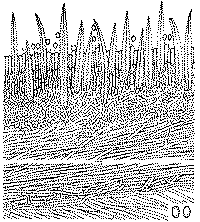|
 Hymenochaete bispora Hymenochaete bispora
BiostatusPresent in region - Indigenous. Endemic
Images (click to enlarge)
Caption: TEST-FIG. 1. Hymenochaete bispora G.H. Cunn. Transverse section x 500; spores x 1000. Original. |
Article: Cunningham, G.H. (1957). Thelephoraceae of New Zealand. XIV. The genus Hymenochaete. Transactions of the Royal Society of New Zealand 85(1): 1-51.
Description: Hymenophore pileate, annual, membranous, effused reflexed with broad resupinate base and
narrow marginal pilei, or resupinate, loosely attached and readily peeling away from the
substratum, forming irregularly linear areas 0.5-16 x 0.5-4 cm. Pilei either reflexed or narrow
upturned edges of broad resupinate areas, to 3 mm across, surface tan or chestnut-brown,
finely hirsute with adpressed radiately arranged hairs; margin crenate, often torn, fawn;
hymenial surface at first fulvous, then chestnut or umber, becoming deeply creviced when the
cinnamon context becomes exposed, velutinate; margin thinning out slightly, lifting readily
and becoming incurved, concolorous, lacerate. Context cinnamon or chestnut-brown, 150-250
µ thick, composed of radiately arranged parallel hyphae bordered by the cortex and a colour
zone beneath the subhymenium, sometimes with islands of similar tissue between; hyphal
system monomitic; generative hyphae varying from 2.5 µ to 6 µ, walls 0.25 µ thick, golden
yellow or hyaline, collapsing readily, freely branched and septate. Setal layer to 150 µ deep,
setae crowded into two overlapping rows, arising in the base of the subhymenium, sometimes
limited to one row, projecting to 80 µ, subulate or as often narrowly fusiform, a few slightly
falcate, 65-145 x 8-10 µ, walls naked, reddish-brown, lumina narrow. Hymenial layer to 50 µ
deep, a dense palisade of basidia and paraphyses. Basidia subclavate, 18-25 x 4.5-6 µ, 1-2
spored; sterigmata erect, slender, to 8 µ long. Paraphyses subclavate, the same diameter but
shorter than the basidia, walls usually tinted yellow. Spores elliptical, or oval, 7-8 x 4.5-5 µ,
walls smooth, hyaline, 0.2 µ thick.
Habitat: HABITAT: On bark of dead fallen branches associated with a white rot.
Distribution: DISTRIBUTION: New Zealand.
Notes: Two structures aid in separating the species from others examined. The hyphal system is
monomitic, an unusual feature in species with the context composed of radiately arranged
parallel hyphae. Basidia bear 1 or 2 broadly elliptical spores, instead of the usual 4.
Pilei are usually upturned margins of broadly resupinate areas, with chestnut-brown surface
clothed in adpressed hairs. Fructifications are loosely attached and tend to peel from the
substratum and curl upwards or inwards, exposing the abhymenial surface, which is clothed
throughout with hairs. The hymemal surface is coloured a rich vandyke-brown, with broad
fulvous margins, and so deeply creviced that the cinnamon context is exposed. Setae are
arranged usually in two overlapping rows; in young plants, or peripheral areas of actively
growing specimens, they are confined to one row. They are soft and flaccid, tending to bend
rather than break when crushed. At first the cortex is scantily developed, but in fertile
specimens attains a thickness of about 30 µ. A second colour zone is tardily developed,
although in mature plants it may form a thick layer of closely intertwined deeply coloured
hyphae lying beneath the subhymenium.
|